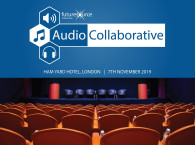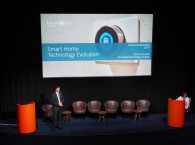
What I feel is also important to add is that, in many industries there are far too many "events" that are much more of a waste of time and money than meetings and conference calls. But when an event is well planned and organized, such as the annual Audio Collaborative conferences, there is no better use of one's time. As I've written before, this is a full day of invaluable insights, expert discussions on relevant topics, and networking opportunities. With this year's event increasing once again in the number of topics addressed, panelists, sponsors, and attendees, I'm not surprised that the most common feedback received by Futuresource was regarding the need to expand the networking time. I agree.
Anyone not familiar with Audio Collaborative can find my 2018 reports here, where a lot happened. Once again, this year's full-day conference on November 7 was invaluable, with Futuresource's leading market analysts and researchers sharing some of the latest stats and trends on the topics in the agenda, combined with great panels and in-between keynotes.
The opening keynote "The Future of Listening" was from Carsten Olesen, president of the consumer audio division at Harman International, a company that has been working frequently with Futuresource on strategic consumer research. Harman is one of the market leaders in most audio product segments, disputing the home audio space precisely with Amazon, also one of the most important distribution partners for Harman and all consumer electronics brands. As Guy Hammett, Market Analyst at Futuresource Consulting reported, "Harman/JBL's strong performance between Q1 and Q3 was enough for it to achieve top home audio vendor for full year 2018. In revenue terms, Harman/JBL, Bose, Sony and Sonos led the pack consistently throughout the year."
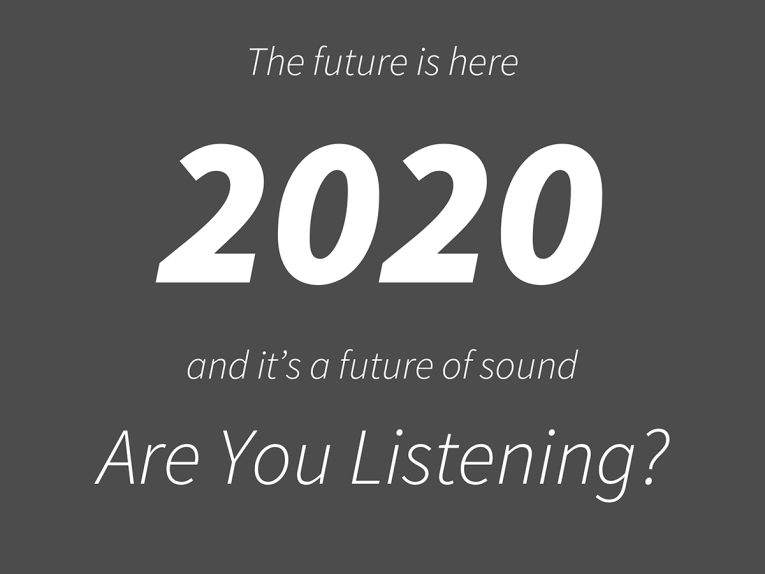
From this research, Olesen concluded that the future of listening looks so bright that consumers better wear shades, "pricking up their ears" (his words) instead. The interesting findings from Harman and Futuresource is that listeners want more personalized audio experiences, as music consumption changes dramatically with mobile devices and streaming services, finally untying the consumer from physical media - what Olesen described as "sound unleashed." The consequences of this shift is also that consumers' priorities today are on "greater sound quality" everywhere, followed by noise cancellation features and better battery life/size. For the future, the research shows that listeners are receptive at 3D/immersive sound, using voice interfaces and getting "smart" features in general (and more research here is needed).
Detailing the "My Personal Sound" trend, Olesen highlighted that current generation technology already allows for customization, and for consumers to listen how and when they like, while predicting that AI for "true personalization," including content following the consumer, and "auto adjust" acoustics will be the mains trends to consider for tomorrow. Will these amount to a "revolution" as Olesen tried to convey? Well, maybe, if we look more carefully at what type of audio content appeals to consumers beyond music.
The impact of new immersive audio technologies and content was precisely what was discussed in the first two panels: "Audio Tech Consumer Lifestyles - Home Audio/Headphones Trends at Home and on the Move," moderated by Simon Bryant, Director of Research at Futuresource Consulting, and "It's Not Just About Music - Podcast Explosion and Audio Book Renaissance," moderated by Tristan Veale, Market Analyst at Futuresource Consulting.
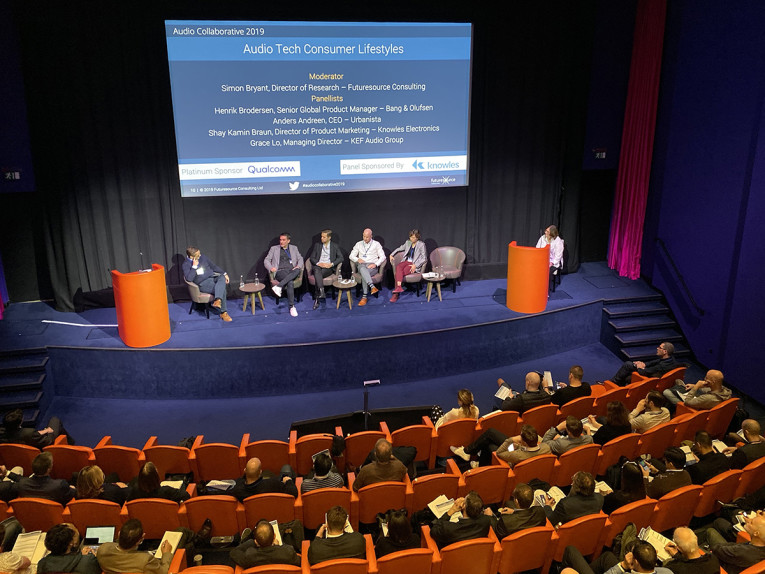
And expanding on the personal audio side, Shay Kamin Braun, Director of Product Marketing at Knowles Electronics, explained how premium sound and personal experiences are increasingly combining, even in the true wireless stereo (TWS) space, where the market has seen explosive growth. As the Knowles executive explained, the TWS segment is just creating a bigger market for personal audio, expanding the market without even cannibalizing the other headphone and earphone form-factors, as the market continues to evolve toward the "technical revolution" of wearables/hearables, with devices that will enable full-day use and will increasingly respond to a broader set of applications, from voice assistants to health monitoring and augmented hearing - just in the next two years. When asked about the promise of 3D audio and immersive experiences, all members of the panel seemed skeptical, agreeing that it will all depend on the content created.
The biggest surprise of all at this Audio Collaborative 2019 event - certainly for me, but I also believe for a lot of attendees - was the revelation by the panel about the Podcast Explosion and the Audio Book Renaissance, that the market is booming, generating already significant revenues in countries like the US, the UK, and Germany (the markets discussed by the panel). While I was well aware that there is an increasing appetite for spoken-word content, and that the rise of the smart speaker and the explosion in the use of headphones on the move was causing a renewed interest in podcasting, I actually had no idea that we could already talk about a thriving industry. Apparently, with the rise of streaming distribution services, and strong investments by companies such as Apple and Spotify, everything changed in the world of audio content, and there is even "podcast drama" episodic content now available and racking up impressive numbers.
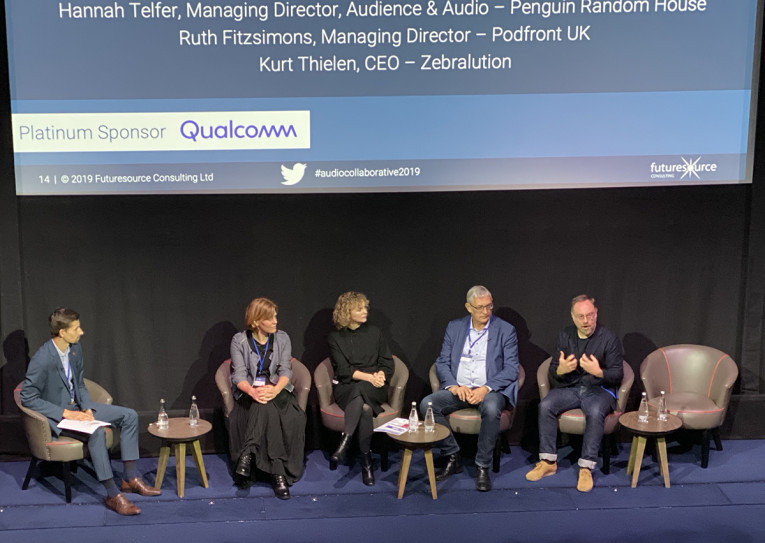
According to Ruth Fitzsimmons, advertising on podcasts is on the rise, 17% of streaming services subscribers listen to podcasts while at home or driving to/from work, and 90% do it on headphones. For me that was the most interesting revelation.
Also, 69% of the people who listen to podcasts listen all the way to the end and prefer to do it on headphones because that way they are able to fully focus on the content. Something that those listeners say doesn't happen while listening in speakers at home, where people are easily distracted. Apparently the experience is not as "immersive," the focus is not as great, and as a result people listen only to parts of the podcast. Other surprising revelations included learning from a large publisher such as Penguin Random House that the people who listen to audiobooks are increasingly male, older, and urban, while a a younger generation - still obsessed with YouTube and ignoring what radio even is - is now increasingly combining music streaming with new types of content such as podcasts and audio books.
This was indeed a fascinating panel, which also discussed how the interactive, nonlinear, and on-demand features of new types of spoken-word content make it totally different from radio; how multiple generations are now showing different preferences on the types of podcasts they listen to - including more escapism; how "headphones make podcasts more visual" and consumers have "screen fatigue;" and even how new types of audio production are combining something similar to the "radio drama" or "audio plays" of yesteryear...
Audio book production is adding rich sound landscapes and the use of multiple voices, paving way to new - richer - forms of content. Combined with the fact that apparently there's a lot of investment pouring in to create more of this type of content, there is also a new type of synergy, where people listening to audio books tend to listen to podcasts about books, and people reading eBooks tend to jump to relevant streaming audio content, creating new opportunities for mixed media.

This article was originally published in The Audio Voice email weekly newsletter. Sign-up here.




